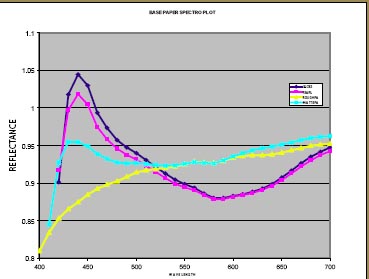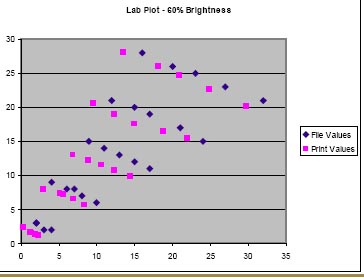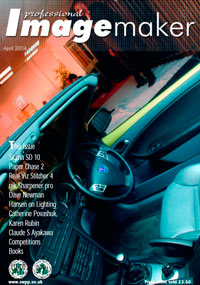articles/Paper/layingtrail-page10
Paper Chase - Laying the Trail - part 10 of 1 2 3 4 5 6 7 8 9 10
by Mike McNamee Published 01/04/2004

The RIP software processes images in the watched folder according to media type and selected printer, applies the appropriate profile and nests the images until it hits a minimal (user specified) paper wastage. It then starts printing automatically. If there is too much blank area then the wait until sufficient area of a paper strip is used to lessen your waste. You can however, always override any of the settings to print at any time.
The software can be set for any type of media in the STUDIO range and control any number of compatible printers. I intend to add a 4000 printer to the 7600 in order to undertake my specialist Giclee printing, preventing excessive paper handling and ink waste from changing cartridges.
epsonTom's Verdict
The system is so user friendly that I don't even worry about it in operation and have almost forgotten it's there! It's like having an extra body in the studio to handle all your printing requirements without paying the wages. The quality and accuracy of the profiles and prints are superb (Mike McNamee confirms this in his technical study of the output on the opposite page).
The Technical Report
The system consists of the Epson 7600 or 4000 models, driven by an Ilford RIP, hosted on an IBM server (2GHz Pentium 4, 512MB RAM 40GB HD, 17" CRT). The package includes assembly, set up, a days on-site training (during which your monitor is calibrated) as well as a year's support and recalibration if needed. The RIP is provided with Ilford-developed profiles for the 4 main papers. These are a Gloss and a Pearl surface based on microporous technology for instant drying and a real photographic feel. The other two surfaces are fine art, a Matte Smooth and a textured art paper. The textured paper is a chain laid, moulded paper with the typical surface tooth of such materials, although the actual surface is unique to Ilford. Both the fine art papers are 100% cotton rag, acid free.Colour Audit
Let the statistics speak for themselves - this was the most accurate colour audit we had conducted to date! Tom used Ilford Studio Pearl on the Epson 7600 using Ultrachrome inks and the Photo Black option. The print was made at 1440dpi using a perceptual rendering intent.
The average DE2000 error was 2.59 just creeping into pole. 12position in our grand summary (all the printers we have profiled) by five hundredths of a point. In Lab Delta E terms this translates to 4.5 average, on a scale in which 4 to 7 is set as contract proof standard. The yellow green, spectral green and spectral blue were the only colours to fall outside this standard.
In the all important flesh tones (for Tom at least) the average error was 2.65DE2000, 2.2 DE Lab. To put this into perspective we sometimes see those sorts of errors when changing paper batches! The split in the errors was 1.5 Lightness, 1.7 Saturation and 0.8 Hue. Generally the flesh tones were slightly desaturated and biased slightly towards yellow. Only one data point is measured for very dark skin tones. This had an error of 0.3, only just within the measuring tolerance of the spectro.
The largest error was in the spectral blue. This is usual as it is the one colour of the Macbeth Color Checker that is out of gamut for the majority of inkjets, especially pigment based ones. The other large error was spectral green, which was desaturated. Despite this the Earth tones were very accurate at 2.7 DE2000 average. This parameter also includes the deep, warm red-browns, which have proven difficult to profile, errors of 7.0 being more typical. Thus the social photographer can expect very accurate stones, grasses and skies to go with their near-perfect skin tones!

GREYSCALE
As might be expected from a RIP-based driver, the linearity of the grey scale is really first class. The response curve runs almost straight, right down to the maximum black of 9.4% (brightness) or 1.93 reflection density. The shadows clog at between 15RGB points and 10RGB points (Adobe 1998) which is close to a full stop more than most of the data we record.
The neutrality of the grey scale is excellent. The residual bias is predominantly cyan to cyan green. The base white of the paper is blue in D65 light by 4.7 Lab points (0.62, -4.73 to be precise) and the RIP profile shifts this towards green at the ¾ tones and almost neutral at the mid-tones. The metameric index at 50% grey is 1.7 Lab Delta E Tungsten to D65. This is very low a value which is probably aided by the neutrality of the swatch in the first place (it measured 52.6, -0.6, -0.4). The only minor flaw in an almost perfect performance is the slight roll off of the whites at the high end. Ink does appear on the page at 250 RGB points but a few more would be helpful especially in a bride's dress. However this effect would only be seen in an otherwise perfect exposure and the precision of that exposure would have to be at 2/10th of a stop or less, an almost impossible task outside of a studio.
The OBA activity on the Pearl paper is less than that on the gloss paper. The lift at 440mn just breached the 100% mark. Under uv light the difference between gloss and pearl was quite pronounced, in normal daylight it was still possible to see that the pearl was not quite as bright. The measurements were quite close at 95.71% Pearl and 96.62% Gloss. The eye can readily detect a 0.5% difference at this end of the scale. The printed picture should illustrate the difference although the tones are out of gamut for magazine print. The differences were more pronounced in the viewing booth.
Mike's Verdict
Overall this audit is a credit to Ilford and fully supports their claims of finely tuned skin tones for the social sector operator. Whilst you pay extra for the additional hardware and service, it will seem like a good investment as soon as the optimised prints come pouring out of the printer! For all practical purposes it can be regarded as a flawless performance - a real pleasure to report upon.
Please Note:
There is more than one page for this Article.
You are currently on page 10
- Paper Chase - Laying the Trail page 1
- Paper Chase - Laying the Trail page 2
- Paper Chase - Laying the Trail page 3
- Paper Chase - Laying the Trail page 4
- Paper Chase - Laying the Trail page 5
- Paper Chase - Laying the Trail page 6
- Paper Chase - Laying the Trail page 7
- Paper Chase - Laying the Trail page 8
- Paper Chase - Laying the Trail page 9
- Paper Chase - Laying the Trail page 10
1st Published 01/04/2004
last update 09/12/2022 14:55:41
More Paper Articles
There are 60 days to get ready for The Society of Photographers Convention and Trade Show at The Novotel London West, Hammersmith ...
which starts on Wednesday 14th January 2026





